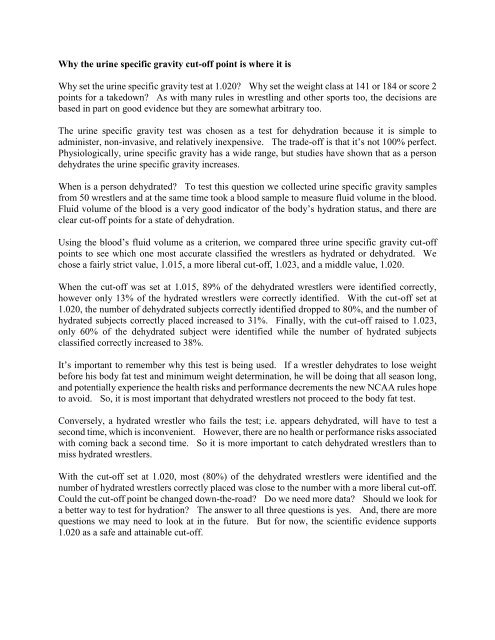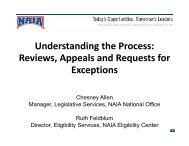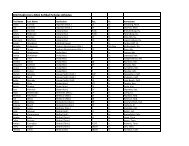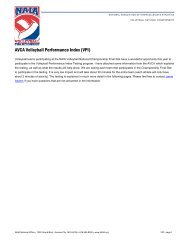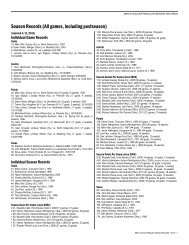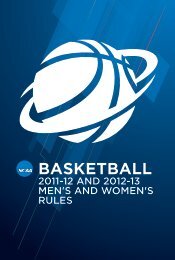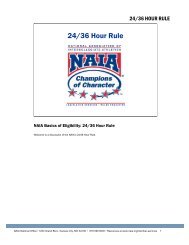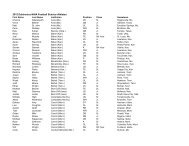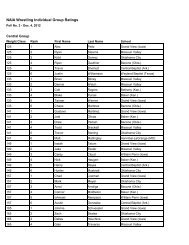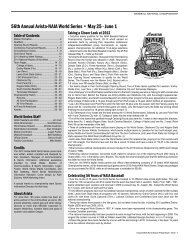NCAA Wrestling Weight Management Program For 2011 - NAIA
NCAA Wrestling Weight Management Program For 2011 - NAIA
NCAA Wrestling Weight Management Program For 2011 - NAIA
Create successful ePaper yourself
Turn your PDF publications into a flip-book with our unique Google optimized e-Paper software.
Why the urine specific gravity cut-off point is where it is<br />
Why set the urine specific gravity test at 1.020? Why set the weight class at 141 or 184 or score 2<br />
points for a takedown? As with many rules in wrestling and other sports too, the decisions are<br />
based in part on good evidence but they are somewhat arbitrary too.<br />
The urine specific gravity test was chosen as a test for dehydration because it is simple to<br />
administer, non-invasive, and relatively inexpensive. The trade-off is that it’s not 100% perfect.<br />
Physiologically, urine specific gravity has a wide range, but studies have shown that as a person<br />
dehydrates the urine specific gravity increases.<br />
When is a person dehydrated? To test this question we collected urine specific gravity samples<br />
from 50 wrestlers and at the same time took a blood sample to measure fluid volume in the blood.<br />
Fluid volume of the blood is a very good indicator of the body’s hydration status, and there are<br />
clear cut-off points for a state of dehydration.<br />
Using the blood’s fluid volume as a criterion, we compared three urine specific gravity cut-off<br />
points to see which one most accurate classified the wrestlers as hydrated or dehydrated. We<br />
chose a fairly strict value, 1.015, a more liberal cut-off, 1.023, and a middle value, 1.020.<br />
When the cut-off was set at 1.015, 89% of the dehydrated wrestlers were identified correctly,<br />
however only 13% of the hydrated wrestlers were correctly identified. With the cut-off set at<br />
1.020, the number of dehydrated subjects correctly identified dropped to 80%, and the number of<br />
hydrated subjects correctly placed increased to 31%. Finally, with the cut-off raised to 1.023,<br />
only 60% of the dehydrated subject were identified while the number of hydrated subjects<br />
classified correctly increased to 38%.<br />
It’s important to remember why this test is being used. If a wrestler dehydrates to lose weight<br />
before his body fat test and minimum weight determination, he will be doing that all season long,<br />
and potentially experience the health risks and performance decrements the new <strong>NCAA</strong> rules hope<br />
to avoid. So, it is most important that dehydrated wrestlers not proceed to the body fat test.<br />
Conversely, a hydrated wrestler who fails the test; i.e. appears dehydrated, will have to test a<br />
second time, which is inconvenient. However, there are no health or performance risks associated<br />
with coming back a second time. So it is more important to catch dehydrated wrestlers than to<br />
miss hydrated wrestlers.<br />
With the cut-off set at 1.020, most (80%) of the dehydrated wrestlers were identified and the<br />
number of hydrated wrestlers correctly placed was close to the number with a more liberal cut-off.<br />
Could the cut-off point be changed down-the-road? Do we need more data? Should we look for<br />
a better way to test for hydration? The answer to all three questions is yes. And, there are more<br />
questions we may need to look at in the future. But for now, the scientific evidence supports<br />
1.020 as a safe and attainable cut-off.


